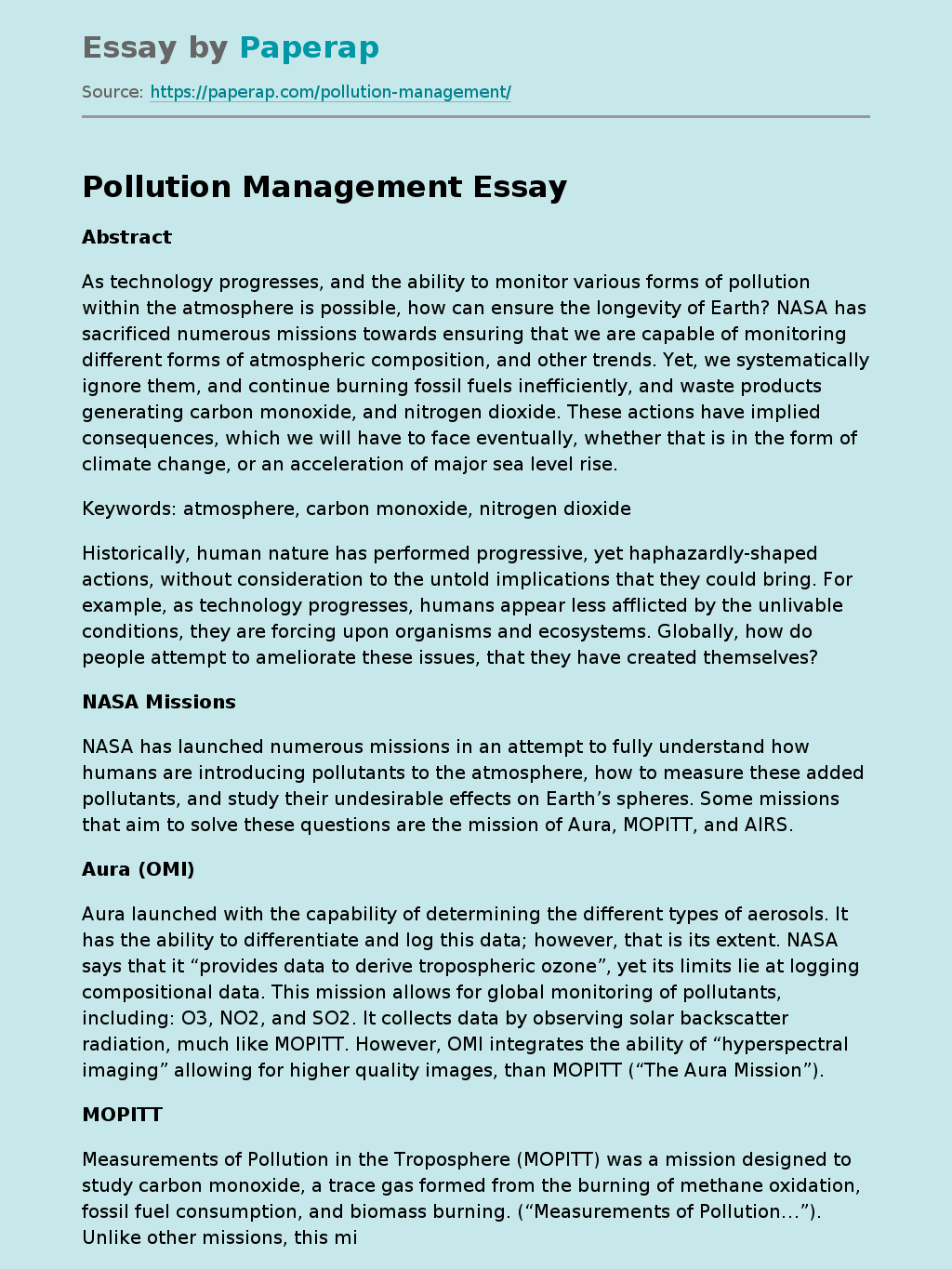Pollution Management
Abstract
As technology progresses, and the ability to monitor various forms of pollution within the atmosphere is possible, how can ensure the longevity of Earth? NASA has sacrificed numerous missions towards ensuring that we are capable of monitoring different forms of atmospheric composition, and other trends. Yet, we systematically ignore them, and continue burning fossil fuels inefficiently, and waste products generating carbon monoxide, and nitrogen dioxide. These actions have implied consequences, which we will have to face eventually, whether that is in the form of climate change, or an acceleration of major sea level rise.
Keywords: atmosphere, carbon monoxide, nitrogen dioxide
Historically, human nature has performed progressive, yet haphazardly-shaped actions, without consideration to the untold implications that they could bring. For example, as technology progresses, humans appear less afflicted by the unlivable conditions, they are forcing upon organisms and ecosystems. Globally, how do people attempt to ameliorate these issues, that they have created themselves?
NASA Missions
NASA has launched numerous missions in an attempt to fully understand how humans are introducing pollutants to the atmosphere, how to measure these added pollutants, and study their undesirable effects on Earth’s spheres.
Some missions that aim to solve these questions are the mission of Aura, MOPITT, and AIRS.
Aura (OMI)
Aura launched with the capability of determining the different types of aerosols. It has the ability to differentiate and log this data; however, that is its extent. NASA says that it “provides data to derive tropospheric ozone”, yet its limits lie at logging compositional data.
This mission allows for global monitoring of pollutants, including: O3, NO2, and SO2. It collects data by observing solar backscatter radiation, much like MOPITT. However, OMI integrates the ability of “hyperspectral imaging” allowing for higher quality images, than MOPITT (“The Aura Mission”).
MOPITT
Measurements of Pollution in the Troposphere (MOPITT) was a mission designed to study carbon monoxide, a trace gas formed from the burning of methane oxidation, fossil fuel consumption, and biomass burning. (“Measurements of Pollution…”). Unlike other missions, this mission used a technique called “gas correlation spectroscopy”, it measures reflected energy rebounded off of the Earth, and due to minor discrepancies within these energy wavelengths is able to correlate these minor signals with different types of gases in the atmosphere (MOPITT).
AIRS
Launched in 2002, AIRS (Atmospheric Infrared Sounder) consists of advanced infrared sensors to create 3-dimensional visualizations of the atmosphere. According to NASA, “AIRS has a spectral resolution more than 100 times greater than previous infrared sounders and provides more accurate information on the vertical profiles of atmospheric temperature and moisture.” This makes more than capable of observing daily weather forecasts, climate changes, and atmospheric composition globally (“Airs: Overview”).
Nitrogen Dioxide
Nitrogen Dioxide is a compound of one nitrogen atom, and two oxygen atoms that can chemically combine with another compound resulting in smog. According to the EPA (Environmental Protection Agency), carbon dioxide accounts for 81% of greenhouse gases emitted from the United States. Ultimately, carbon dioxide is produced with the burning of biomass, solid waste, and formed within specific manufacturing processes. Plant life effectively removes carbon dioxide from the atmosphere. Yet, it can be inferred that human activity is the fault for its increase in the atmosphere in recent years. Since it is considered a greenhouse gas, it is capable of trapping and concentrating heat globally, effectively speeding up climate change (‘Overview of Greenhouse Gases’, 2018).
Carbon Monoxide
Like nitrogen dioxide, carbon monoxide, a combination of one carbon and one oxygen, can chemically combine to form smog. Carbon monoxide is formed through burning “carbon-based fuels, such as coal, wood, and oil, burn incompletely or inefficiently”. After analyzing the data obtained by MOPITT, within the United States most of the carbon monoxide is found in urban areas (Levy). This gas, can then be blown by winds, and distributed globally. This gas is being studied, as being subjected to it for prolonged amounts of time, can lead to an eventual death, and more likely minor problems such as: lung irritation, difficulty concentrating.
Effects
Human have caused numerous changes to the atmosphere’s composition. In the past century, ozone within the troposphere, has doubled. As a response, the average rate of change of temperature per year, has increased from about 0.7-0.9 degrees Fahrenheit to approximately 1.3-1.6 degrees Fahrenheit (‘Ozone in the Atmosphere’). This has led to climate change, and the global sea level rise. Sea level rise, in relation to global warming is sensible; however, the concerning factor is that the amount the sea level is rising is accelerating with time. Unlike previous assumptions, that the change in sea level was a linear constant. If the acceleration continues at this rate, the sea level rise can be expected to be approximately 26 inches by 2100 (Weeman & Lynch, 2018).
As scientific evidence proves time and time again, that human interaction can be tied to these disastrous implications within the Earth’s spheres. At what point, will we attempt to solve this problem, and to what avail. While some effects are inevitable, it is clear that the time to formulate a global solution to combat this issue is before it becomes a problem, or at least a problem which we cannot solve.
References
- AIRS: Overview. (2014, March 31). Retrieved February 9, 2019, from https://airs.jpl.nasa.gov/mission_and_instrument/overview
- Carbon Monoxide (CO). (n.d.). Retrieved February 9, 2019, from http://www.environment.gov.au/protection/publications/factsheet-carbon-monoxide-co
- Levy, R. (n.d.). Carbon Monoxide. Retrieved from https://earthobservatory.nasa.gov/global-maps/MOP_CO_M
- MEASUREMENTS OF POLLUTION IN THE TROPOSPHERE (MOPITT). (n.d.). Retrieved from https://www2.acom.ucar.edu/mopitt
- Overview of Greenhouse Gases. (2018, October 31). Retrieved from https://www.epa.gov/ghgemissions/overview-greenhouse-gases
- Ozone in the Atmosphere. (n.d.). Retrieved from
- http://sunshine.chpc.utah.edu/Labs/OurAtmosphere/ozone_main.html
- The Aura Mission. (n.d.). Retrieved from https://aura.gsfc.nasa.gov/omi.html
- Thome, K. (n.d.). MOPITT. Retrieved February 9, 2019, from https://terra.nasa.gov/about/terra-instruments/mopitt
- Weeman, K., & Lynch, P. (2018, February 13). New study finds sea level rise accelerating – Climate Change: Vital Signs of the Planet. Retrieved from https://climate.nasa.gov/news/2680/new-study-finds-sea-level-rise-accelerating/
Pollution Management. (2021, Nov 11). Retrieved from https://paperap.com/pollution-management/

